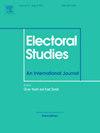城乡分化:分析挪威40多年的调查数据
IF 2.3
2区 社会学
Q1 POLITICAL SCIENCE
引用次数: 0
摘要
近年来,城乡居民之间的政治分歧似乎有所扩大。当前的文献描述了绿色、进步和左倾的城市选民和民族主义和保守的农村人口的崛起。然而,研究通常缺乏多数主义制度之外这些发展的历史数据。我们通过分析挪威40多年的数据,为欧洲多党制福利国家的城乡差距演变提供了新的见解,并提出了以下问题:从长期来看,城乡在政治问题上的差距是如何演变的?利用独特的选举调查数据,我们分析了1977年至2021年间挪威农村和城市选民的态度和最重要的问题是如何变化的。我们还评估了城乡差异是否由社会人口变化驱动。我们的结果既表明了稳定性,也表明了变化性。一方面,我们发现挪威在一些问题上的态度两极分化:随着时间的推移,城市人口比农村居民表现出更进步的态度,环境政策的分歧有所增加。农村居民越来越关心中心和外围问题。然而,在其他领域,我们发现稳定和相对较低的两极分化程度。例如,挪威的农村人口在道德和宗教问题上与城市居民越来越相似。此外,农村居民在经济问题上并没有变得更加右倾,这是在更具对抗性的体制中发现的。本文章由计算机程序翻译,如有差异,请以英文原文为准。
The urban-rural cleavage: Analysing more than 40 years of Norwegian survey data
In recent years, the political divide between urban and rural dwellers seems to have increased. Current literature has described the rise of a green, progressive and left-leaning urban electorate and a nationalist and conservative rural population. However, research usually lacks historical data on these developments outside of majoritarian systems. We provide new insights into the urban-rural divide's evolution in a European multi-party welfare state by analysing more than four decades of data from Norway and asking: How has the urban-rural divide over political issues evolved from a long-term perspective? Using unique election survey data, we analyse how both attitudes and most important issues among rural and urban voters in Norway have changed between 1977 and 2021. We also assess whether urban-rural differences are driven by sociodemographic change. Our results indicate both stability and change. On one hand, we find attitude polarisation in Norway on some issues: Divisions over environmental policy have increased, as the urban population displays more progressive attitudes than rural citizens over time. Rural citizens have become more concerned with centre and periphery issues. However, in other areas, we find stability and a relatively low degree of polarisation. For example, the rural population in Norway has become more similar to urban citizens regarding moral and religious issues. Furthermore, rural citizens have not become more right-leaning on economic questions, which has been a finding in more adversarial systems.
求助全文
通过发布文献求助,成功后即可免费获取论文全文。
去求助
来源期刊

Electoral Studies
POLITICAL SCIENCE-
CiteScore
3.40
自引率
13.00%
发文量
82
审稿时长
67 days
期刊介绍:
Electoral Studies is an international journal covering all aspects of voting, the central act in the democratic process. Political scientists, economists, sociologists, game theorists, geographers, contemporary historians and lawyers have common, and overlapping, interests in what causes voters to act as they do, and the consequences. Electoral Studies provides a forum for these diverse approaches. It publishes fully refereed papers, both theoretical and empirical, on such topics as relationships between votes and seats, and between election outcomes and politicians reactions; historical, sociological, or geographical correlates of voting behaviour; rational choice analysis of political acts, and critiques of such analyses.
 求助内容:
求助内容: 应助结果提醒方式:
应助结果提醒方式:


